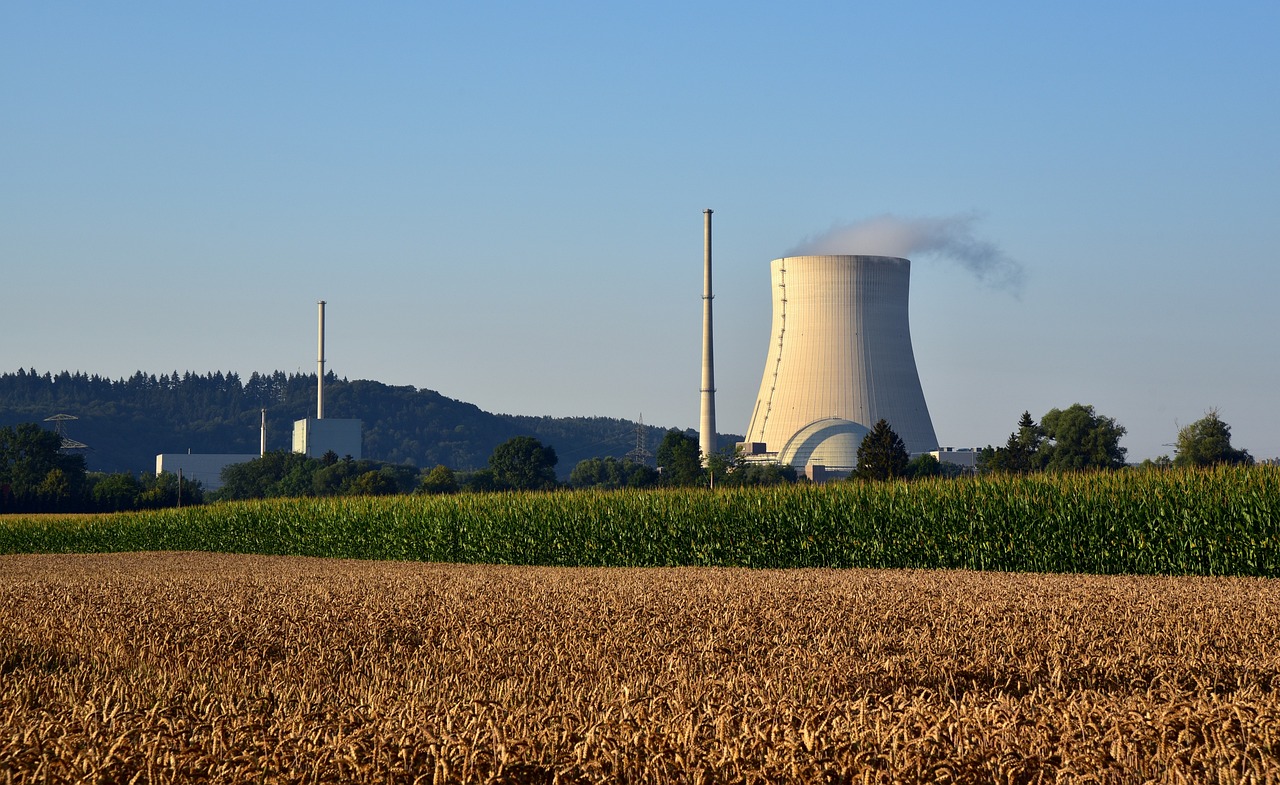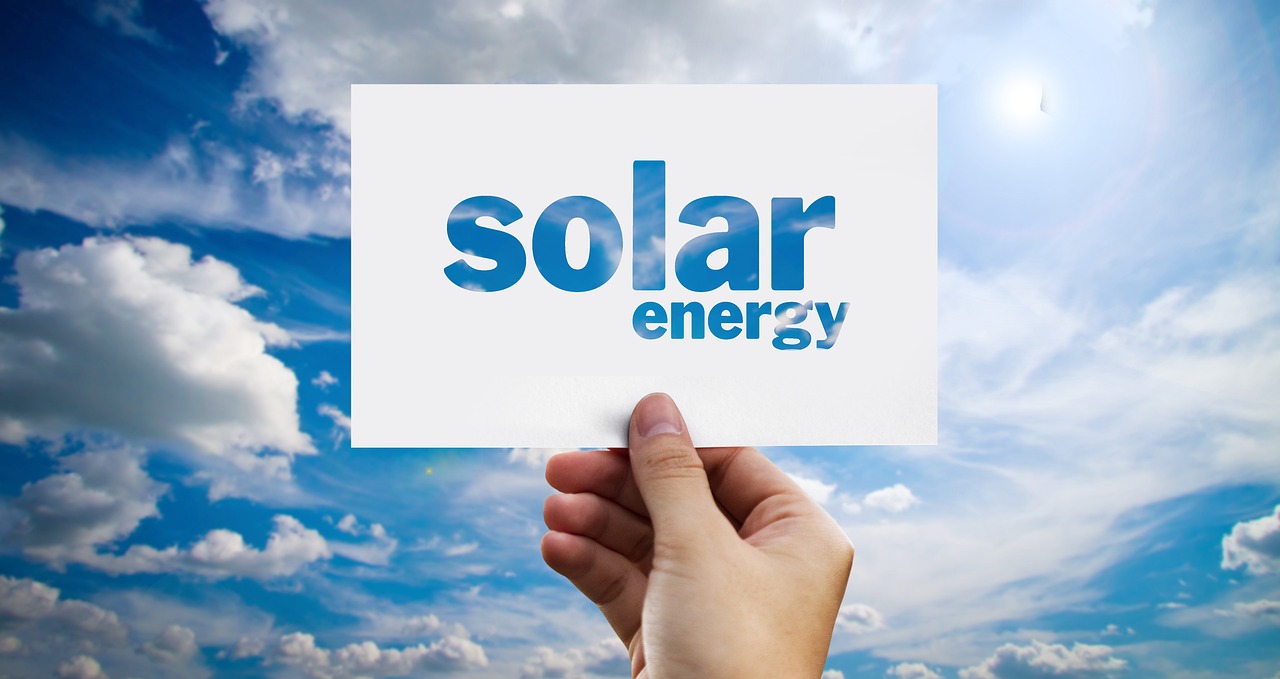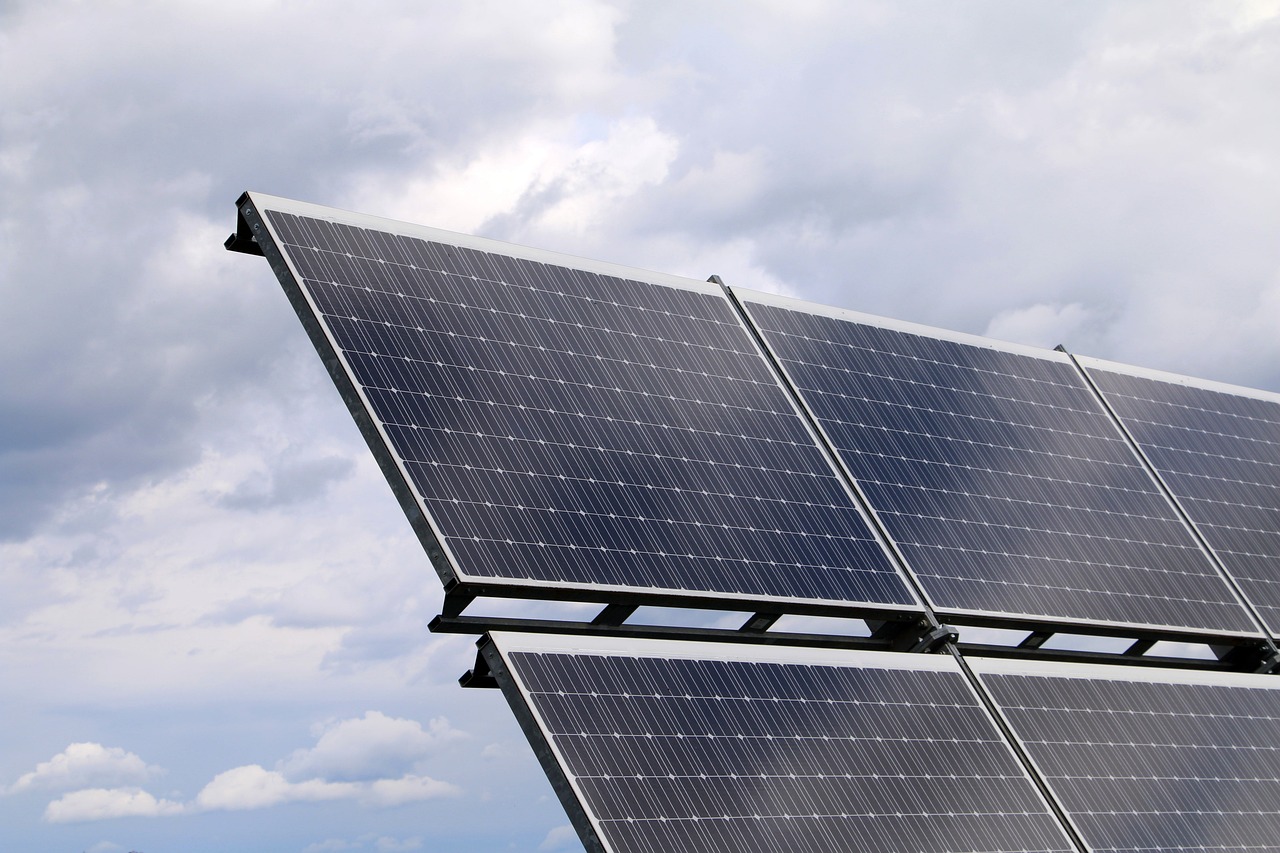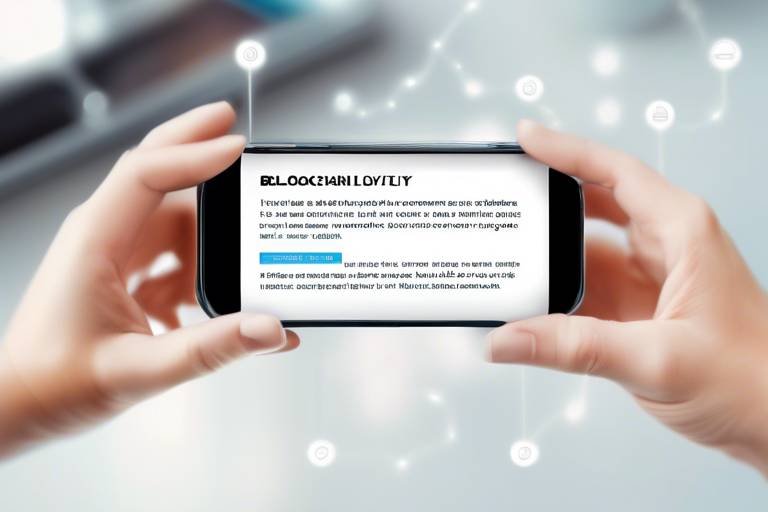How Blockchain Can Support Energy Efficiency Initiatives
In a world increasingly concerned with sustainability and reducing carbon footprints, the intersection of blockchain technology and energy efficiency is more relevant than ever. Imagine a system where energy consumption is optimized, waste is minimized, and transparency reigns supreme. This isn’t just a dream; it’s becoming a reality thanks to blockchain. By leveraging decentralized systems, we can enhance sustainability across various sectors, making energy efficiency not just a goal, but a tangible achievement.
Blockchain operates as a decentralized ledger, allowing for secure and transparent transactions without the need for a central authority. This technology can revolutionize how we manage energy consumption and distribution. As we dive deeper into this topic, we’ll explore not only how blockchain can tackle existing challenges in energy efficiency but also how it can empower consumers and producers alike. So, let’s unravel the potential of this innovative technology!
Before we delve into its applications in energy efficiency, let’s take a moment to understand what blockchain is all about. At its core, blockchain is a distributed database that maintains a continuously growing list of records, known as blocks. Each block contains a timestamp and a link to the previous block, creating a secure chain of information. This structure ensures that once data is recorded, it cannot be altered without altering all subsequent blocks, making it virtually tamper-proof.
One of the fundamental principles of blockchain is its decentralization. Unlike traditional systems that rely on a central authority, blockchain distributes control across a network of computers, known as nodes. This not only enhances security but also fosters transparency, as all participants in the network can access the same information. With this foundational understanding, we can appreciate how blockchain can address the pressing challenges in energy efficiency.
Despite the urgent need for energy efficiency, the sector faces numerous challenges. One of the most significant issues is the inefficiencies in energy distribution. Traditional energy grids are often outdated, leading to significant energy losses during transmission. Additionally, there’s a lack of transparency in energy consumption data, making it difficult for stakeholders to make informed decisions. Finally, high operational costs can stifle innovation and hinder the implementation of energy-saving technologies.
Decentralization can be a game-changer in addressing these challenges. By empowering both consumers and producers, we can create a more efficient energy management system. Imagine a world where households can generate their own energy from renewable sources and sell excess energy back to the grid. This shift not only reduces reliance on centralized utilities but also encourages individuals to actively participate in energy conservation.
One of the most exciting applications of blockchain in energy efficiency is peer-to-peer energy trading. This innovative approach allows consumers to buy and sell renewable energy directly with one another, bypassing traditional utility companies. For instance, if a neighbor has solar panels and produces more energy than they need, they can sell that excess energy to you, creating a win-win situation. This not only promotes the use of renewable energy but also fosters a sense of community.
Another fascinating aspect of blockchain technology is the use of smart contracts. These self-executing contracts automate transactions and agreements, ensuring efficient energy distribution. For example, a smart contract can automatically trigger the sale of energy when certain conditions are met, such as price thresholds or energy demand levels. This automation not only reduces administrative overhead but also incentivizes energy-saving behaviors among consumers.
One of the cornerstones of blockchain is its ability to enhance data transparency and security. In energy efficiency initiatives, this is crucial for building trust among stakeholders. With blockchain, all transactions are recorded in an immutable ledger, providing a clear audit trail. This transparency can help identify inefficiencies, track energy consumption patterns, and ultimately encourage more responsible usage of energy resources.
To illustrate the real-world impact of blockchain on energy efficiency, let’s look at some successful projects that have harnessed this technology. These case studies not only showcase the potential benefits but also provide valuable insights into how blockchain can be integrated into existing energy systems.
Several renewable energy projects have adopted blockchain technology to improve efficiency and reduce costs. For example, the Power Ledger platform enables users to trade renewable energy directly, facilitating a decentralized energy market. This not only enhances community engagement but also maximizes the use of renewable resources, showcasing how blockchain can drive sustainable energy practices.
Traditional utility companies are also recognizing the potential of blockchain. By implementing blockchain solutions, they can streamline operations, enhance customer service, and promote energy efficiency initiatives. For instance, some utilities are using blockchain to manage energy distribution more effectively, ensuring that energy is delivered where it’s needed most, thus minimizing waste.
Looking ahead, the future of blockchain in the energy sector is promising. Emerging trends, such as the integration of Internet of Things (IoT) devices with blockchain, are set to revolutionize energy management. As policy frameworks evolve to support these innovations, we can expect a surge in the adoption of blockchain technology across the energy landscape. This transformation will not only enhance efficiency but also pave the way for a more sustainable and resilient energy future.
- What is blockchain technology? - Blockchain is a decentralized digital ledger that records transactions across multiple computers, ensuring the security and transparency of data.
- How does blockchain improve energy efficiency? - By enabling peer-to-peer trading, automating contracts, and enhancing transparency, blockchain optimizes energy distribution and consumption.
- Can blockchain help reduce energy costs? - Yes, by streamlining operations and promoting renewable energy trading, blockchain can lead to significant cost savings for consumers and producers alike.
- What are smart contracts? - Smart contracts are self-executing agreements with the terms directly written into code, allowing for automated and efficient transaction processing.

Understanding Blockchain Technology
Blockchain technology is often described as a revolutionary force, much like the internet was in its infancy. At its core, blockchain is a decentralized ledger that records transactions across many computers in such a way that the registered transactions cannot be altered retroactively. This ensures that the data remains secure and transparent, which is crucial for applications in various sectors, including energy efficiency.
To grasp the essence of blockchain, imagine it as a digital chain of blocks, where each block contains a list of transactions. When a new transaction occurs, it is grouped with others into a block. This block is then added to the chain in a linear, chronological order. The decentralized nature of blockchain means that no single entity has control over the entire chain; instead, it is maintained by a network of computers, or nodes, that validate and record transactions.
Here are some fundamental principles that underpin how blockchain operates:
- Decentralization: Unlike traditional databases that are controlled by a central authority, blockchain is distributed across a network, making it less vulnerable to failures or attacks.
- Transparency: Each participant in the network has access to the entire chain of transactions, which promotes accountability and trust.
- Immutability: Once a transaction is recorded in a block and added to the chain, it cannot be changed or deleted, ensuring the integrity of the data.
- Consensus Mechanisms: Blockchain networks use various algorithms to achieve agreement on the validity of transactions, ensuring that all parties are in sync.
These principles make blockchain an ideal candidate for addressing some of the pressing challenges in the energy sector. For instance, the energy industry often struggles with inefficiencies in distribution and a lack of transparency in transactions. By utilizing blockchain technology, companies can create a more streamlined and efficient system that not only optimizes energy consumption but also promotes sustainability.
Moreover, blockchain's ability to securely store and share data can facilitate improved energy management. With accurate and real-time data available to all stakeholders, energy producers and consumers can make informed decisions that lead to enhanced efficiency and reduced waste. In essence, blockchain technology is not just a buzzword; it is a powerful tool that can transform how we approach energy efficiency initiatives.

Energy Efficiency Challenges
In today's world, where energy consumption is skyrocketing and sustainability is becoming a critical concern, energy efficiency is more important than ever. However, the journey toward achieving optimal energy efficiency is fraught with challenges that can feel overwhelming. One of the most pressing issues is the inefficiencies in energy distribution. Often, energy is lost in transmission due to outdated infrastructure, which not only wastes resources but also contributes to higher costs for consumers. Imagine pouring a glass of water only to find that half of it spills on the floor; that’s how energy distribution often works.
Another significant hurdle is the lack of transparency in energy markets. Consumers frequently have no idea where their energy comes from or how much they are truly consuming, making it difficult to make informed decisions. This opacity can lead to distrust among consumers and producers alike, stifling innovation and collaboration. It's like trying to navigate a maze blindfolded—without visibility, you’re bound to hit walls and make wrong turns.
Moreover, high operational costs are a major barrier to implementing energy-efficient solutions. Many companies and households are unwilling or unable to invest in energy-efficient technologies because the initial costs can be daunting. This reluctance is further compounded by the fact that the benefits of energy efficiency often take time to materialize, which can make stakeholders hesitant to commit. It's akin to planting a seed; you have to wait patiently for it to grow before you can enjoy its fruits.
Additionally, regulatory challenges can also impede progress. Governments and regulatory bodies often lag behind technological advancements, creating a legal landscape that can be confusing and restrictive. This lack of alignment between innovation and regulation can stifle the adoption of energy-efficient technologies and practices. Think of it like trying to drive a car on a road with constantly changing speed limits; it’s hard to know how fast you can go without getting pulled over.
Finally, the cultural inertia surrounding energy consumption habits poses yet another challenge. Many individuals and organizations are simply accustomed to their current ways of consuming energy, making them resistant to change. Changing these habits requires not just technology, but also a shift in mindset—a monumental task that can take years to achieve. It’s like trying to teach an old dog new tricks; the effort is there, but the results may not come overnight.
In summary, the path to energy efficiency is littered with obstacles ranging from inefficiencies in distribution to cultural resistance. However, recognizing these challenges is the first step toward overcoming them. With innovative solutions like blockchain technology on the horizon, there’s hope for a more efficient and sustainable energy future.

Decentralization in Energy Systems
Decentralization in energy systems is like taking the power back from a central authority and distributing it among the people. Imagine a world where energy isn't just something you consume from a utility company, but rather a resource you can manage, trade, and optimize in your own community. This shift towards decentralization is not just a trend; it's a revolution that empowers both consumers and producers, fostering a more dynamic and efficient energy landscape. With blockchain technology at the helm, this transformation becomes not only possible but also practical.
One of the most significant advantages of decentralization is that it enhances energy management. Instead of relying solely on centralized utilities that often struggle with inefficiencies and high operational costs, decentralized systems enable local communities to generate, share, and consume energy as they see fit. This local energy generation can come from renewable sources such as solar panels or wind turbines, allowing communities to harness their natural resources while reducing their carbon footprint. By decentralizing energy production, we can significantly reduce transmission losses, which occur when electricity travels long distances from power plants to consumers.
Furthermore, decentralization fosters a sense of community and collaboration. When individuals and businesses can produce their own energy, they become active participants in the energy market. This engagement leads to a more informed consumer base that is aware of their energy consumption patterns and can make conscious decisions to reduce waste. In a decentralized system, energy trading becomes a reality. Individuals can sell excess energy generated from their solar panels to their neighbors, creating a peer-to-peer energy trading network. This not only promotes sustainability but also encourages energy efficiency by incentivizing individuals to optimize their consumption.
However, decentralization is not without its challenges. For instance, the integration of various energy sources and managing the balance between supply and demand can be complex. This is where blockchain technology shines, providing a secure and transparent platform for transactions and data management. By utilizing smart contracts, energy transactions can be automated, ensuring that energy is distributed efficiently and fairly. Moreover, blockchain enhances security by creating an immutable record of all energy exchanges, which builds trust among participants in the system.
In summary, decentralization in energy systems is a game-changer. It empowers consumers, promotes renewable energy use, and optimizes energy management. With the support of blockchain technology, we can create a more resilient and efficient energy infrastructure that benefits everyone involved. As we move forward, embracing this shift will be crucial in addressing the pressing challenges of energy consumption and sustainability.
- What is decentralization in energy systems?
Decentralization in energy systems refers to the distribution of energy production and management away from centralized utilities, enabling local communities to generate and consume energy independently. - How does blockchain support decentralization?
Blockchain technology provides a secure and transparent platform for managing energy transactions, allowing for peer-to-peer trading and automated agreements through smart contracts. - What are the benefits of decentralized energy systems?
Decentralized energy systems can reduce transmission losses, empower consumers, promote renewable energy use, and create a more engaged community. - What challenges does decentralization face?
Challenges include integrating various energy sources, managing supply and demand balance, and ensuring security and transparency in transactions.

Peer-to-Peer Energy Trading
Imagine a world where you can sell excess energy from your solar panels directly to your neighbor without having to go through a utility company. This is the essence of peer-to-peer (P2P) energy trading, a revolutionary concept made possible by blockchain technology. By leveraging decentralized networks, P2P energy trading allows consumers to engage directly with one another, creating a marketplace for renewable energy that is not only efficient but also promotes sustainability.
At its core, P2P energy trading is about empowering individuals. It shifts the traditional energy paradigm from a centralized model, where large utility companies control the distribution and pricing of energy, to a more democratic approach. In this new model, individuals can buy and sell energy based on their needs and excess production, leading to a more efficient allocation of resources. This system not only reduces energy waste but also encourages the use of renewable energy sources, as individuals are incentivized to produce more green energy.
How does this work in practice? Let's break it down. When a homeowner generates excess energy—say, from solar panels—they can list this surplus energy on a blockchain-enabled platform. Other consumers in the network can then purchase this energy directly. The transaction is recorded on the blockchain, ensuring transparency and security. This eliminates the need for intermediaries, reducing costs and increasing the profitability for energy producers.
One of the standout features of P2P energy trading is its ability to foster community engagement. Imagine a neighborhood where households collaborate to meet their energy needs. Not only does this strengthen community ties, but it also provides a localized solution to energy consumption. Consumers can choose to buy energy from their neighbors, knowing that they are supporting local production and reducing their carbon footprint.
However, this innovative approach is not without its challenges. Regulatory frameworks need to adapt to accommodate these new trading models, and there are technical hurdles to overcome in terms of ensuring reliable energy distribution. Moreover, consumers must be educated about the benefits and workings of P2P trading to fully embrace this shift.
Despite these challenges, the potential benefits of P2P energy trading are significant. For instance, studies have shown that communities utilizing P2P trading can reduce their overall energy costs by up to 30%. This is a win-win situation: consumers save money, while the environment benefits from increased reliance on renewable energy sources.
In conclusion, peer-to-peer energy trading represents a paradigm shift in how we think about energy consumption and distribution. By harnessing the power of blockchain technology, we can create a more sustainable, efficient, and community-focused energy landscape. As we move forward, it will be crucial for stakeholders—governments, companies, and consumers alike—to collaborate in developing the necessary frameworks that will allow this innovative model to thrive.
- What is peer-to-peer energy trading? - It is a system that allows consumers to buy and sell excess energy directly with one another, facilitated by blockchain technology.
- How does blockchain enhance P2P energy trading? - Blockchain provides a secure and transparent platform for recording transactions, eliminating the need for intermediaries.
- What are the benefits of P2P energy trading? - It empowers consumers, reduces energy waste, promotes renewable energy use, and can lower overall energy costs.
- What challenges does P2P energy trading face? - Regulatory hurdles, technical challenges, and the need for consumer education are significant barriers to widespread adoption.

Smart Contracts for Energy Management
When we talk about energy management, the term "smart contracts" often pops up, and for good reason! Imagine a world where energy transactions happen seamlessly, without the need for intermediaries. This is the magic of smart contracts, which are self-executing contracts with the terms of the agreement directly written into code. They operate on blockchain technology, ensuring that all transactions are transparent, secure, and traceable.
So, how do smart contracts actually work in the realm of energy management? Let’s break it down:
- Automation: Smart contracts automate energy transactions. For instance, if a homeowner generates excess solar energy, a smart contract can automatically sell this energy to a neighbor without any manual intervention. This not only saves time but also reduces the potential for human error.
- Real-time data: By integrating smart meters with blockchain, energy consumption data can be recorded in real-time. Smart contracts can utilize this data to adjust energy prices dynamically based on supply and demand, ensuring a fair and efficient market.
- Incentivization: Smart contracts can incentivize energy-saving behaviors. For example, a household that reduces its energy consumption during peak hours could receive tokens or discounts, encouraging more sustainable practices.
Moreover, smart contracts can facilitate peer-to-peer energy trading. This means that individuals can buy and sell energy directly from each other, bypassing traditional utility companies. Such a decentralized approach not only promotes energy efficiency but also empowers consumers to take control of their energy usage. Think of it as a community-driven marketplace for energy!
One of the standout features of smart contracts is their ability to ensure compliance and accountability. Once a smart contract is deployed, it cannot be altered. This immutability guarantees that all parties adhere to the agreed terms, fostering trust among participants. In the energy sector, where trust is paramount, this feature can significantly enhance collaboration between consumers, producers, and utility companies.
However, it's essential to recognize that while the potential of smart contracts in energy management is vast, there are still challenges to overcome. Issues such as regulatory hurdles, the need for widespread adoption, and the integration of existing infrastructure with blockchain technology must be addressed. Yet, as we continue to explore innovative solutions, the future of smart contracts in energy management looks promising.
In summary, smart contracts are revolutionizing the way we manage energy. By automating transactions, ensuring transparency, and promoting sustainable practices, they pave the way for a more efficient and decentralized energy landscape. The transition to smart contracts could very well be the key to unlocking the full potential of renewable energy and achieving global sustainability goals.
Q1: What are smart contracts?
Smart contracts are self-executing contracts with the terms of the agreement directly written into code, allowing for automated and secure transactions without intermediaries.
Q2: How do smart contracts improve energy efficiency?
They automate transactions, provide real-time data for dynamic pricing, and incentivize energy-saving behaviors, leading to more efficient energy management.
Q3: Can I trade energy with my neighbors using smart contracts?
Yes! Smart contracts enable peer-to-peer energy trading, allowing individuals to buy and sell energy directly, promoting a decentralized energy marketplace.
Q4: What challenges do smart contracts face in the energy sector?
Challenges include regulatory hurdles, the need for widespread adoption, and the integration of existing infrastructure with blockchain technology.

Data Transparency and Security
When we talk about energy efficiency, one of the biggest hurdles we face is the lack of transparency in data management. Imagine trying to navigate a maze blindfolded; that's what stakeholders in the energy sector often feel like when they can't access reliable data. Blockchain technology steps in like a superhero, offering a decentralized ledger that not only records transactions but also ensures that every piece of data is visible and immutable. This means that once information is entered into the blockchain, it cannot be altered or deleted, creating a level of trust that is often missing in traditional systems.
The security aspect of blockchain is equally impressive. In an era where data breaches are all too common, having a system that employs cryptographic techniques to secure information is a game-changer. Each transaction is encrypted and linked to the previous one, creating a chain that is incredibly difficult to tamper with. This level of security is crucial for energy efficiency initiatives, as it protects sensitive consumer data and ensures that energy transactions are executed without the risk of fraud.
Moreover, blockchain enables real-time monitoring of energy consumption and production. This transparency allows consumers to make informed decisions about their energy use, leading to more sustainable practices. For instance, if a household can see their energy consumption in real-time, they might be encouraged to shift their usage to off-peak times, ultimately reducing demand and lowering costs. This is where the magic of data transparency meets practical application.
In addition to enhancing trust and security, blockchain can also facilitate collaboration among various stakeholders in the energy sector. When data is transparent, it becomes easier for energy producers, consumers, and regulators to work together towards common goals. For example, if a utility company can see how much renewable energy is being generated and consumed in a community, they can better plan for grid demands and integrate more sustainable practices.
To summarize, the integration of blockchain technology into energy efficiency initiatives brings a plethora of benefits centered around data transparency and security. With a decentralized system, stakeholders can trust the data they are working with, leading to better decision-making and ultimately, a more sustainable energy future. The shift from opaque systems to transparent ones is not just a technological upgrade; it’s a fundamental change that can reshape how energy is produced, consumed, and managed.
As we continue to explore the role of blockchain in energy efficiency, it's clear that the potential for innovation is vast. By ensuring that data is both transparent and secure, we can foster an environment where efficiency thrives, paving the way for a greener planet.

Case Studies in Energy Efficiency
When it comes to energy efficiency, real-world examples can be the best teachers. Numerous case studies highlight how blockchain technology is not just a buzzword but a transformative force in the energy sector. One such example is the Power Ledger project in Australia. This innovative platform allows homeowners with solar panels to sell excess energy directly to their neighbors. By facilitating peer-to-peer energy trading, Power Ledger has managed to create a more efficient energy distribution system that minimizes waste and maximizes renewable energy utilization.
Another notable case is the Brooklyn Microgrid, which empowers local residents to generate and trade energy within their community. This initiative leverages blockchain to track energy transactions securely and transparently, ensuring that participants are fairly compensated for their contributions. The result? A vibrant local energy market that not only reduces reliance on traditional utilities but also promotes sustainable practices among community members.
Moreover, traditional utility companies are also jumping on the blockchain bandwagon. For instance, Siemens has been exploring the use of blockchain to enhance the efficiency of their energy systems. By integrating blockchain into their operations, they aim to streamline processes, reduce operational costs, and improve customer service. This not only boosts their bottom line but also aligns with global sustainability goals.
| Case Study | Location | Key Features | Benefits |
|---|---|---|---|
| Power Ledger | Australia | Peer-to-peer energy trading | Increased renewable energy use, reduced waste |
| Brooklyn Microgrid | New York, USA | Community energy trading | Local energy market, enhanced sustainability |
| Siemens Blockchain Initiative | Global | Streamlined operations | Cost reduction, improved customer service |
These examples illustrate the diverse applications of blockchain in enhancing energy efficiency. They show that whether it’s empowering individuals or optimizing the operations of large utility companies, blockchain has the potential to reshape the energy landscape. As more projects like these emerge, the vision of a decentralized, efficient, and sustainable energy future becomes increasingly attainable.
- What is blockchain technology?
Blockchain is a decentralized digital ledger that records transactions across many computers in such a way that the registered transactions cannot be altered retroactively, ensuring security and transparency. - How does blockchain improve energy efficiency?
By enabling peer-to-peer trading, automating transactions through smart contracts, and enhancing data transparency, blockchain can significantly reduce waste and optimize energy consumption. - Are there risks associated with blockchain in energy?
Like any technology, blockchain has its risks, including cybersecurity threats and regulatory challenges. However, its potential benefits often outweigh these concerns.

Renewable Energy Projects
In recent years, the convergence of blockchain technology and renewable energy projects has ushered in a new era of sustainability and efficiency. Imagine a world where energy is not just consumed but actively traded among peers, where every kilowatt-hour is tracked and verified through a decentralized ledger. This is not a distant dream but a reality being shaped by innovative projects around the globe. These initiatives leverage blockchain to tackle the inefficiencies that have long plagued the energy sector, transforming how we produce, distribute, and consume energy.
One standout example is the Power Ledger project in Australia. This platform allows homeowners with solar panels to sell their excess energy directly to neighbors, creating a localized energy market. By utilizing blockchain, Power Ledger ensures that all transactions are transparent and secure, eliminating the need for intermediaries. This not only empowers consumers but also enhances the overall efficiency of the energy system. Imagine being able to sell your surplus energy on a sunny day—it's like turning your home into a mini power plant!
Another noteworthy project is WePower, based in Europe, which focuses on enabling renewable energy producers to raise capital by tokenizing their energy. This innovative approach allows producers to sell energy in advance, ensuring a steady cash flow while giving investors access to green energy at a lower cost. Think of it as a farmer selling future crops; it provides stability for both producers and consumers, driving investment in renewable resources.
Moreover, the integration of blockchain in these projects fosters community engagement and participation. For instance, the Brooklyn Microgrid initiative allows residents to buy and sell energy within their community. This not only promotes the use of renewable sources but also strengthens local economies by keeping energy transactions within the neighborhood. It’s a bit like a farmer’s market for energy—local, fresh, and sustainable!
As we look to the future, the potential for blockchain in renewable energy projects is immense. With increasing awareness of climate change and the need for sustainable practices, these initiatives are paving the way for a greener tomorrow. By harnessing the power of decentralization, we can create a more resilient and efficient energy landscape that benefits everyone. The question is, are we ready to embrace this change?
| Project Name | Location | Key Features | Impact |
|---|---|---|---|
| Power Ledger | Australia | Peer-to-peer energy trading | Increased solar energy usage and community engagement |
| WePower | Europe | Tokenization of energy | Improved funding for renewable projects |
| Brooklyn Microgrid | USA | Community energy trading | Strengthened local economies and energy independence |
These projects exemplify how blockchain can not only enhance operational efficiency but also foster a sense of community and shared responsibility towards energy consumption. By embracing these technologies, we can work towards a future where energy is not just a commodity, but a collaborative resource that benefits all.
- What is blockchain technology? Blockchain is a decentralized digital ledger that records transactions across many computers in a way that the registered transactions cannot be altered retroactively.
- How does blockchain improve energy efficiency? By enabling peer-to-peer energy trading and automating transactions through smart contracts, blockchain reduces waste and optimizes energy distribution.
- Can blockchain help in reducing energy costs? Yes, by eliminating intermediaries and enabling direct transactions, blockchain can lower operational costs and make energy more affordable.
- Are there any risks associated with blockchain in energy? While blockchain offers many benefits, challenges such as regulatory compliance and cybersecurity must be addressed to ensure safe and effective implementation.

Utility Companies Implementing Blockchain
As the world shifts towards more sustainable energy solutions, utility companies are increasingly looking at blockchain technology as a way to enhance their operations. Imagine a world where energy is not just consumed but also traded seamlessly among users. This vision is becoming a reality as utility companies begin to embrace decentralized systems. By implementing blockchain, these companies can streamline their processes, improve customer interactions, and ultimately promote energy efficiency initiatives.
One of the most significant advantages of blockchain for utility companies is the ability to create a more transparent and efficient energy marketplace. Traditional energy systems often suffer from inefficiencies due to outdated infrastructure and lack of real-time data. With blockchain, utility companies can track energy production and consumption in real-time, providing a clear view of energy flows. This transparency not only helps in reducing operational costs but also builds trust among consumers who are increasingly demanding accountability from their energy providers.
Moreover, blockchain enables smart contracts that automate various processes. These contracts can execute transactions when predefined conditions are met, such as automatically billing customers based on their energy consumption. This level of automation reduces administrative burdens and minimizes the chances of human error, leading to a more efficient operational workflow. For instance, if a customer uses energy during peak hours, a smart contract can adjust their billing accordingly, incentivizing them to shift their usage to off-peak times.
Utility companies are also exploring the concept of peer-to-peer (P2P) energy trading. This innovative approach allows consumers to sell excess energy generated from their solar panels directly to their neighbors, creating a community-driven energy market. Not only does this empower consumers, but it also helps in balancing energy supply and demand within local grids. By leveraging blockchain, transactions between peers can be securely recorded, ensuring that all parties involved are fairly compensated for their contributions.
To illustrate the impact of blockchain in the utility sector, consider the following table showcasing some pioneering utility companies that have successfully integrated blockchain technology into their operations:
| Utility Company | Location | Blockchain Application | Benefits |
|---|---|---|---|
| Power Ledger | Australia | P2P Energy Trading | Increased consumer engagement, reduced energy costs |
| LO3 Energy | USA | Local Energy Markets | Enhanced grid resilience, community empowerment |
| Enel | Italy | Smart Metering | Real-time data access, improved billing accuracy |
In conclusion, the implementation of blockchain technology by utility companies is paving the way for a more efficient and sustainable energy future. By enhancing transparency, automating processes, and enabling innovative trading models, these companies are not just adapting to the changing landscape but are also leading the charge towards a greener planet. The transition may still be in its infancy, but the potential for blockchain to revolutionize the energy sector is undeniable.
- What is blockchain technology? Blockchain is a decentralized digital ledger that records transactions across many computers securely and transparently.
- How does blockchain improve energy efficiency? By providing transparency, automating processes through smart contracts, and enabling peer-to-peer trading, blockchain reduces waste and optimizes energy use.
- Are there any real-world examples of blockchain in energy? Yes, companies like Power Ledger and LO3 Energy are successfully using blockchain for peer-to-peer energy trading and local energy markets.
- What are the challenges of implementing blockchain in utility companies? Challenges include regulatory hurdles, technological integration, and the need for consumer education.

The Future of Blockchain in Energy
The future of blockchain technology in the energy sector is not just a fleeting trend; it's a transformative force that promises to reshape how we produce, distribute, and consume energy. As we stand on the brink of this new era, it's essential to recognize the potential innovations that blockchain can bring to the table. Imagine a world where energy transactions are as seamless as sending an email. This is not just a dream—it's becoming a reality.
One of the most exciting prospects is the emergence of decentralized energy markets. With blockchain, consumers can become prosumers, actively participating in the energy market by producing their own energy through solar panels or wind turbines and selling excess energy back to the grid. This shift not only empowers individuals but also fosters a sense of community, as neighbors can trade energy amongst themselves. Think of it as a local farmers’ market, but for energy—where everyone has the chance to contribute and benefit.
Moreover, the integration of artificial intelligence (AI) with blockchain could lead to highly efficient energy management systems. For instance, AI algorithms could analyze energy consumption patterns and optimize the distribution of energy in real-time. This would ensure that energy is used most efficiently, reducing waste and lowering costs. The combination of these technologies could revolutionize how we approach energy efficiency and sustainability.
However, with great potential comes great responsibility. As the adoption of blockchain in energy grows, so does the need for robust regulatory frameworks. Policymakers will play a crucial role in shaping the future landscape of blockchain technology. They must ensure that regulations keep pace with innovations to protect consumers and encourage fair competition. Collaboration between governments, industry leaders, and technology developers will be vital in crafting policies that foster innovation while safeguarding public interests.
To illustrate this potential, consider the following table that highlights key trends and innovations expected in the blockchain energy sector:
| Trend/Innovation | Description |
|---|---|
| Decentralized Energy Grids | Local energy production and consumption, reducing reliance on centralized utilities. |
| Smart Contracts | Automated agreements that streamline energy transactions and improve efficiency. |
| Enhanced Data Security | Blockchain’s inherent security features protect sensitive energy data from breaches. |
| Consumer Empowerment | Prosumers can control their energy usage and trade surplus energy, promoting sustainability. |
As we look ahead, the role of education and awareness cannot be overstated. Stakeholders across the energy sector must be informed about the benefits and functionalities of blockchain technology. Workshops, seminars, and online resources can help demystify blockchain and empower individuals and businesses to embrace this change. The more we understand, the more we can innovate.
In conclusion, the future of blockchain in energy is bright and full of potential. With its ability to enhance efficiency, promote sustainability, and empower consumers, blockchain technology is set to be a game-changer in the energy sector. As we continue to explore its possibilities, one thing is clear: the energy landscape is about to undergo a radical transformation, and those who adapt will thrive in this new environment.
- What is blockchain technology? Blockchain is a decentralized digital ledger that records transactions across many computers in a way that the registered transactions cannot be altered retroactively.
- How does blockchain improve energy efficiency? By enabling decentralized energy markets, peer-to-peer trading, and smart contracts, blockchain reduces inefficiencies and promotes more sustainable energy practices.
- What are the challenges of implementing blockchain in energy? Key challenges include regulatory hurdles, the need for standardization, and the integration of existing energy infrastructure with new blockchain solutions.
- Can blockchain help with renewable energy adoption? Yes, blockchain facilitates the trading of renewable energy, making it easier for individuals and businesses to invest in and utilize sustainable energy sources.
Frequently Asked Questions
- What is blockchain technology?
Blockchain technology is a decentralized digital ledger that records transactions across multiple computers. This ensures that the recorded transactions cannot be altered retroactively, providing a high level of security and transparency. Think of it as a digital notebook that everyone can see, but no one can erase!
- How does blockchain improve energy efficiency?
Blockchain enhances energy efficiency by enabling decentralized systems where users can manage their energy consumption more effectively. It allows for peer-to-peer energy trading, which reduces waste and optimizes energy usage. Imagine being able to trade your excess solar power with your neighbor, all tracked securely on a blockchain!
- What are smart contracts?
Smart contracts are self-executing contracts with the terms of the agreement directly written into code. They automatically execute and enforce agreements when certain conditions are met, making energy transactions smoother and more efficient. It's like having a vending machine for energy – you put in your coins (conditions), and it delivers your energy without needing a cashier!
- What challenges does the energy sector face?
The energy sector faces multiple challenges, such as inefficiencies in energy distribution, high operational costs, and a lack of transparency. These issues can hinder the progress toward achieving better energy efficiency. It's like trying to navigate through a foggy road; you know your destination, but the obstacles make the journey tricky!
- Can you give examples of blockchain in energy projects?
Sure! There are numerous real-world examples where blockchain has been successfully implemented in energy projects. For instance, some renewable energy initiatives use blockchain to track energy production and consumption, allowing for better resource management and community engagement. Think of it as a community garden where everyone knows who planted what and when, ensuring fair sharing!
- What is peer-to-peer energy trading?
Peer-to-peer energy trading allows consumers to buy and sell energy directly with one another, often using blockchain technology to facilitate these transactions. This system encourages the use of renewable energy sources and promotes sustainability. It's like a local farmer's market, but instead of fruits and veggies, you're trading energy!
- How can utility companies benefit from blockchain?
Utility companies can streamline their operations, improve customer service, and promote energy efficiency initiatives through blockchain technology. By adopting blockchain, they can manage energy distribution more effectively and enhance trust with their customers. Imagine a utility company that runs like a well-oiled machine, where every cog works in harmony!
- What does the future hold for blockchain in the energy sector?
The future looks bright for blockchain in the energy sector, with emerging trends and innovations set to reshape how we consume and trade energy. As policies evolve to support these technologies, we can expect more widespread adoption and new solutions to energy efficiency challenges. It's like watching a seed grow into a flourishing tree, providing shade and fruit for everyone!



















